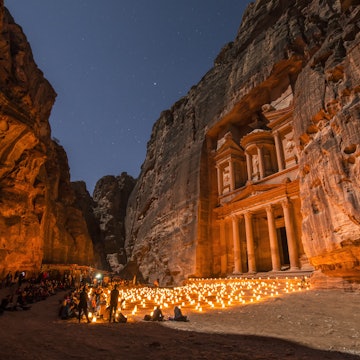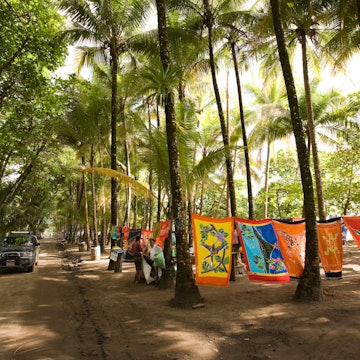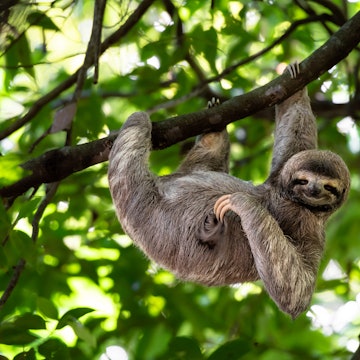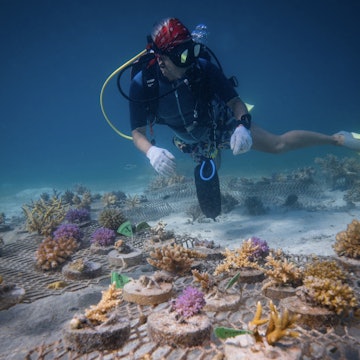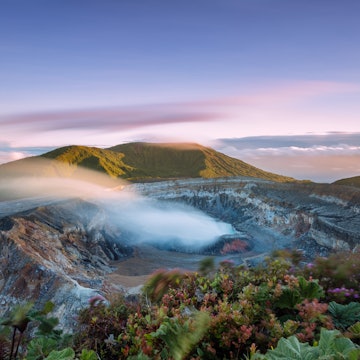

Bahía Drake on the Península de Osa. Sam Camp/Getty Images
Even before first light, the growl of howler monkeys echoes through the trees. A lumbering tapir retreats into the cover of the forest for its daily rest, while a pair of scarlet macaws emits an unsonorous squawk and alights in search of breakfast. Day breaks in the coastal rainforest.
Welcome to the Península de Osa, a wild and remote corner of Costa Rica, which happens to be one of the most biodiverse places on the planet. Here, 2.5% of the world’s flora and fauna are crammed into 0.01% of its area.
We’ll do the math for you: that’s over 400 kinds of birds and nearly 300 different mammals and reptiles. Not to mention the mind-blowing 10,000 species of creepy, crawly and buzzy insects.
They all live among the lushness of 4000-plus types of trees and plant life. The Península de Osa is a veritable Eden, offering Costa Rica’s best chances to see wildlife in its natural habitat, including some rare species that you’re unlikely to see anywhere else.
That’s why intrepid travelers make the long and sometimes arduous journey down to Costa Rica’s southwestern corner, braving rough roads, limited mobile coverage and otherwise rustic conditions. Here’s what you need to know to make the most of your trip to this wildlife wonderland.

When should I go to the Península de Osa?
Peak season in the Osa runs from mid December to mid April, with extra high prices around the holidays (Christmas, New Years and Easter weeks). This busy season corresponds roughly with the dry season.
Keep in mind, of course, that this is the rainforest. It rains year-round, but the wet weather is usually limited to shorter, afternoon showers during the dry season. The tradeoff for the sunny skies is more travelers and significantly higher prices.
Rains start to pick up from May to August, but crowds are lighter and prices are lower. September, October and November are the wettest months, with up to 12 inches of rain per month.
Note that travel to the Osa is very challenging during these months, due to impassable roads and washed-out trails. Many businesses close during the rainiest months.
How much time should I spend in the Península de Osa?
Give yourself at least four days, which is enough time to visit Parque Nacional Corcovado and then recover on a deserted beach, plus an extra tour or two.
If you have a week, you can do more independent exploration around your home base, whether it is Puerto Jiménez or Bahía Drake. And with more than a week, you’ll have time to check out both sides of the Península de Osa.

Is it easy to get in and around the Península de Osa?
Nope! But it’s worth the effort. To get here, you can fly into Puerto Jiménez or Bahía Drake from San José (both are 50-minute flights).
Another popular way to get here is to fly into Sierpe, also from San José, then take a scenic boat ride down the Río Sierpe to Bahía Drake.
If you have time and wheels, it’s fairly straightforward to drive to Puerto Jiménez, diverging from Rte 2 (aka the Interamericana) and heading south on Rte 245.
Your private vehicle will be useful to get around the eastern side of the peninsula. Make sure you rent a 4WD to cover the challenging roads to smaller villages and to Carate (on the outskirts of Corcovado).
For travelers with no vehicle, many tour companies offer transportation. There are also affordable colectivo trucks from Puerto Jiménez to Carate and to Dos Brazos.
Driving to Bahía Drake is easier than it used to be, thanks to some new bridges, but it’s still not the best way to get there. The route is unpaved and rough in some places, and once you arrive, it’s difficult – if not impossible – to drive anywhere outside of the main village of Agujitas.
A better option is to fly or boat in, then take advantage of the transportation provided by lodges and tour companies. In any case, plan for a lot of hiking.

Top things to do in Península de Osa
Wild beaches, untrodden hiking trails and aquatic adventures are among the many enticements to the Península de Osa. Wherever you go and whatever you do, keep your eyes open for the resident creatures.
Hang out with wild things in Parque Nacional Corcovado
Covering one-third of the Península de Osa, Parque Nacional Corcovado is the main draw to this remote corner of Costa Rica. The park protects a large stand of lowland tropical forest and provides a home for abundant wildlife.
A visit to Corcovado promises sightings of creatures great and small, including several rare and endangered species.
Keep your eyes peeled for all four species of new-world monkeys, including the endangered squirrel monkey; several species of snakes, including the venomous fer-de-lance; and many mammals such as the endangered Baird’s tapir, anteaters, sloths and peccaries.
Hundreds of species of birds also inhabit these forests: it’s hard to miss the stunning (and noisy) scarlet macaws.
You can visit Corcovado on a day-trip from either Puerto Jiménez or Bahía Drake, but that is not the best way to explore this natural wonderland. You’ll be sharing the trails with scores of other wannabe naturalists, and you’ll miss the best times for spotting creatures (early morning and early evening).
If you want to see the Osa at its wildest, plan to spend a night or two at Sirena station, ideally hiking in and out.
Note that all visitors to Corcovado must be accompanied by a licensed guide. Guides are trained to spot and identify flora and fauna, and they play a critical role in keeping visitors safe on the trail. Recommended tour companies include Osa Wild and Picolina Tours.

Snorkel with sea turtles at Isla del Caño
Located about 24km offshore from Agujitas, in Bahía Drake, Reserva Biológica Isla del Caño is an uninhabited island and a marine reserve, offering Costa Rica’s best snorkeling and diving.
Surrounding the island, the crystal clear waters and extensive coral reef are home to sea creatures galore.
The island’s lack of rivers and streams means minimal runoff, contributing to the water’s clarity. Don your mask and snorkel and look out for both reef sharks and bull sharks, several species of sea turtles and scores of colorful fish.
Book your trip with Drake Bay Diving or Costa Rica Adventure Divers, both located in Bahía Drake.
Kayak through murky mangroves or paddle a bioluminescent bay
There are untold worlds to discover from the seat of a kayak when you set off from Puerto Jiménez, whether independently or on a tour.
The Reserva Forestal Golfo Dulce is a rare and stunning seascape – a tropical fjord – teeming with dolphins, whales and spectacular scenery. When night falls, the water in some places glows with bioluminescent magic.
This phenomenon is caused by a curious phytoplankton that lets off light when stimulated by movement in the water. It feels like stars have fallen out of the sky and into the water as you paddle through the twinkling bay.
Only a few kilometers away, the Preciosa-Platanares Mixed Wildlife Refuge provides a completely different but no less captivating kayaking experience. Here, paddlers can explore the ins and outs of the life-rich mangroves.
This endangered ecosystem plays an essential role in preventing erosion, enriching the soil and filtering carbon from the earth.
And, of course, it is a habitat for countless creatures, especially aquatic birds, crocodiles and iguanas. Aventuras Tropicales and Osa Wild offer kayak tours to both destinations.
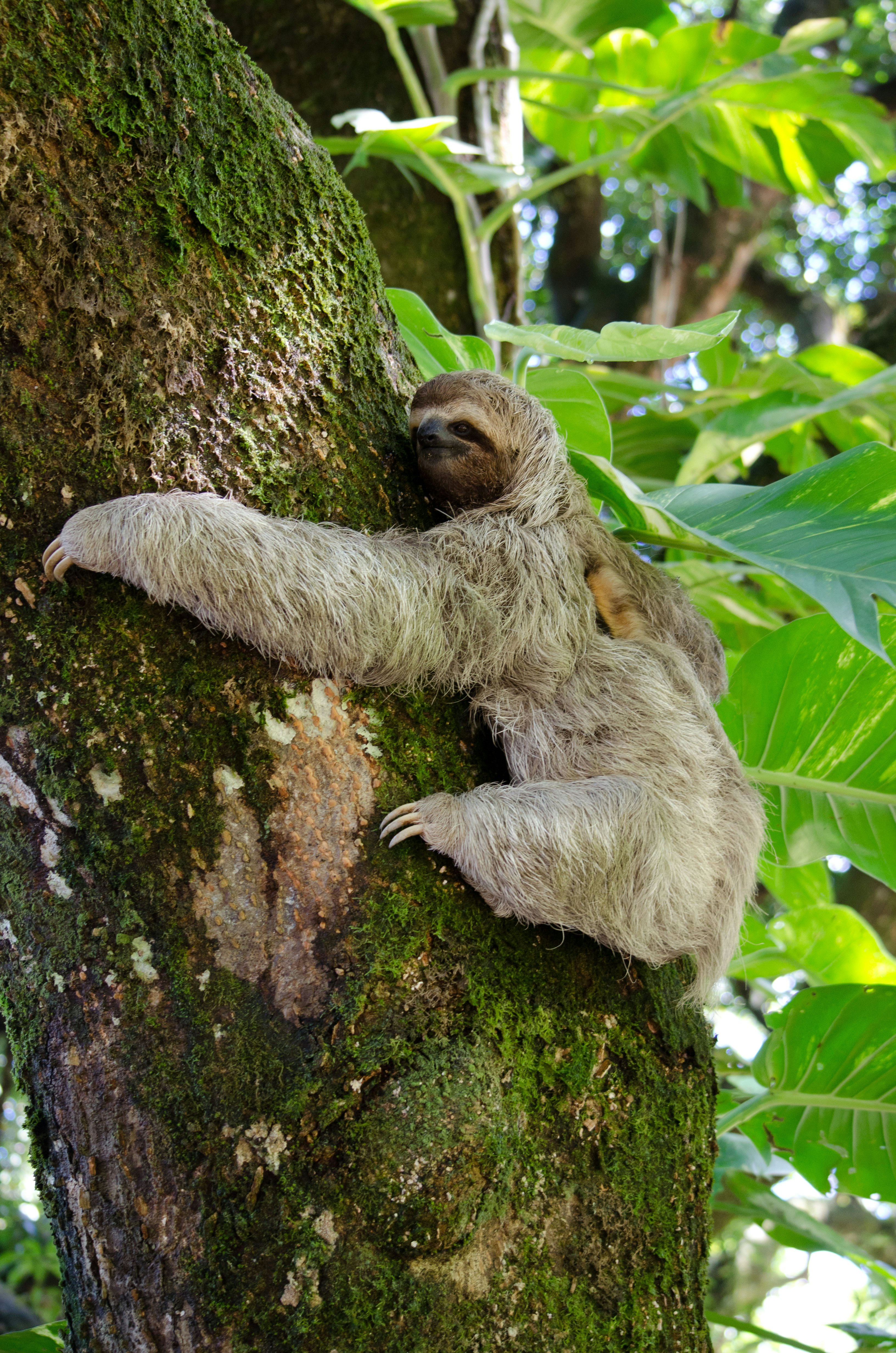
Spy on sloths swinging in the treetops
The Valverde family farm was once slated for cattle ranching and palm farming. But the La Palma property contains a swath of rainforest that is – apparently – a favorite sloth hangout.
So the family opted to conserve the habitat, opening up the walking trails to guests and converting the farm into La Perica Sloth Garden.
Family members and friends guide guests through the property, pointing out the many smiling sloths that are hanging above. Sightings of sloths are practically guaranteed, not to mention the countless other birds, insects and animals that inhabit the property.
Ending with a homemade lunch, the experience epitomizes the hospitality and eco-consciousness that Costa Rica is famous for.
Swim under waterfalls and sleep in the open air
If you’re curious about the Osa’s wild beauty – but not the crowds and high prices – you may want to check out the tiny village of Dos Brazos.
In this rural community on the northwest border of Corcovado, the main source of income is not tourism, but gold mining. (Yes, you can try your hand at this labor-intensive job while you’re there).
In this lesser-known location, Bolita is a unique and affordable eco-lodge and hostel, set on 60 hectares of pristine rainforest, replete with 15km of hiking trails, four waterfalls and two glorious lookouts.
The lodging is simple but stylish, with rustic rooms that are covered but otherwise open to the sounds and sights and scents of the surrounding forest.
Be aware that Bolita is not only for naturalists, but also for naturists: the grounds and buildings are clothing-optional. Spend a night or spend a year in this paradisical setting.
My favorite thing to do in the Península de Osa
Corcovado is the big attraction on the Península de Osa, but you don’t actually have to enter the park for an incredible wildlife adventure.
My favorite thing to do is to walk the coastal trails, either along the Cabo Matapalo on the east side of the peninsula, or along the Drake Trail on the west side.
No guide required! Chances are good for spotting capuchin and spider monkeys, scarlet macaws and plenty of other birds and creatures.
Both trails connect a series of gorgeous and often deserted beaches, where you can stop for a picnic or a cooling dip.
The Drake beaches are generally wider and sandier, while the Matapalo beaches are rock-strewn and scenic (but still swimmable). A river-crossing or a waterfall swim may also be a part of your itinerary, depending on which route you choose.
How much money do I need for the Península de Osa?
Costa Rica is expensive by Central American standards, and the Península de Osa is expensive by Costa Rican standards. Bahía Drake is especially pricey because it is so remote and services are limited.
That means that travelers are dependent on tour companies or lodgings for transportation and even food, in some cases. Budget travelers will have an easier time in Puerto Jiménez, where more low-cost options are available and it’s easier to operate independently.
On a tight budget, you can get by on less than $100 a day. Nicer lodgings and organized tours will increase your expenses significantly.
Be aware that there are no banks or ATMs in Bahía Drake. The two ATMs in Puerto Jiménez dispense both Costa Rica colones (¢) and US dollars ($). (The two currencies are essentially interchangeable in Costa Rica.)
Many – but not all – local businesses accept credit cards, but they may charge a fee. In any case, it’s not unusual for technical difficulties to interfere with the functioning of ATMs and credit card machines, so bringing extra cash is always recommended.
Night at Life for Life Hostel: US$45 per person
Night at Iguana Lodge in the green/dry season: from US$250 per couple
Night at Lapa Rios Lodge in the green/dry season: from $760 per couple
Breakfast from Nature Cafe in Bahía Drake: from US$12
Meal at Aventuras Cafe in Puerto Jiménez: from US$20
Four-course sunset dinner at Tranquilo Lodge: from $65 per person
Colectivo from Puerto Jiménez to Carate: $20
Three-hour kayak tour: from $60
Day/overnight trip to Corcovado: from $130
Additional things to know about the Península de Osa
Essential packing item: waterproof sandals
Waterproof sandals are ideal for beach landings, river crossings, waterfall swimming and other essential Osa activities. Close-toed sandals are recommended (and sometimes required) for many activities.
It rains a lot in the rainforest
The rainforest is a wet climate at any time of year. It’s best to pack for rain, even if you are traveling in the so-called dry-season.
Bring sturdy, waterproof boots for hiking on muddy trails. Be prepared for showers (or downpours) with a quick-drying, moisture-wicking base layer and a light-weight waterproof rain jacket.
Stay safe on the trail and in the surf
The biggest danger to travelers in Costa Rica? Rip tides. Beaches on the Península de Osa are mostly unguarded, and many don’t have warning flags. Always be cautious about swimming and surfing alone.
Remember: don’t struggle against a current pulling you out to sea; instead, swim parallel to the shore until you are free from the current.
When hiking, be sure to inform someone (a park ranger, a reserve attendant or your lodge receptionist) before setting out, and always stay on marked trails. Watch out for snakes on the trail and never approach wild animals. (It’s illegal to feed or take a selfie with a wild animal!)











